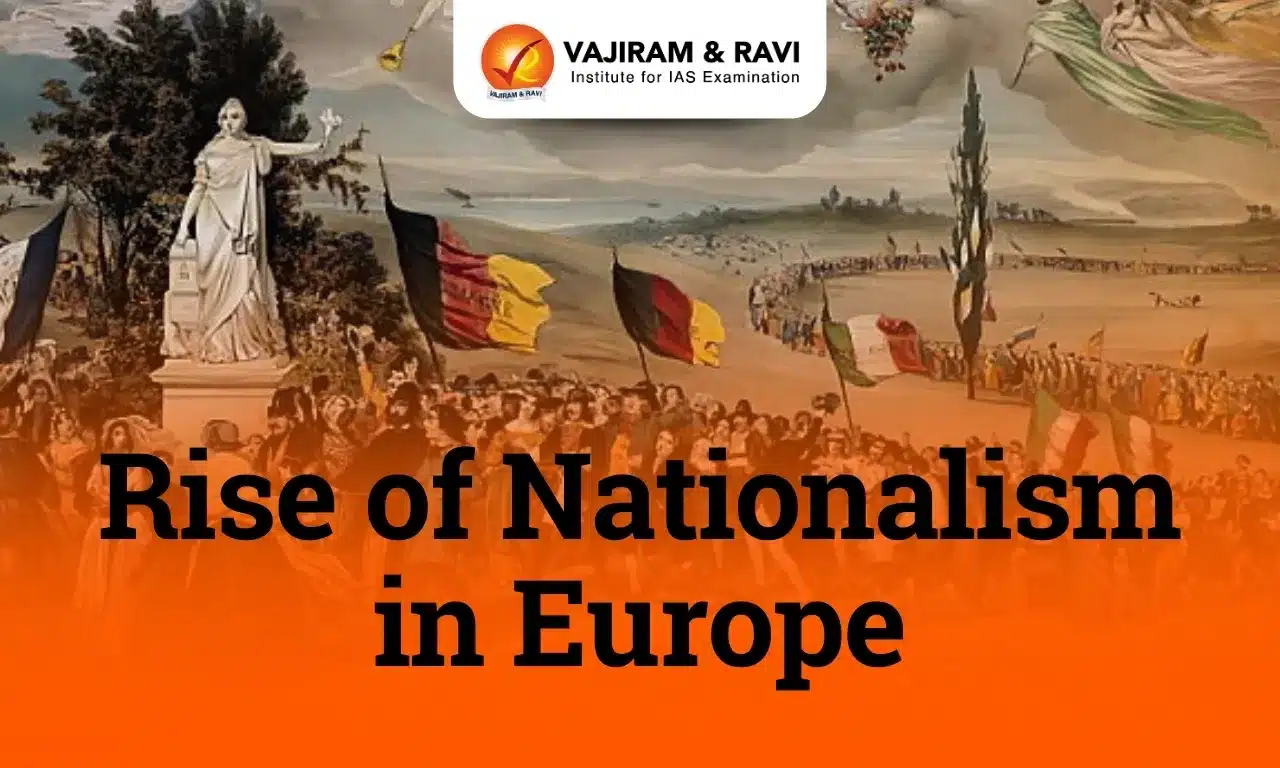The rise of nationalism in Europe is associated with the birth of nation-states. In some countries, it contributed to the formation of states after the unification of territories having a shared culture such as in Italy and Germany whereas; in some, it was due to the resistance against imperial powers governing multicultural empires such as in the Russian and Ottoman empires. The most important influence for this profound transformation was the French Revolution, which had shaken the foundations of an absolute monarchy and paved the way for a state where sovereignty lay in the hands of the people. The ultimate consequence of this nationalism culminated in the two world wars.
Idea of Nationalism in Europe
In 1848, Frédéric Sorrieu, a French artist, created a series of four prints, named La République Universelle Démocratique et Sociale (The universal democratic and social republic) illustrating his vision of a world consisting of democratic and social republics.
- Utopian Vision of Unity: The first of the 4 prints portrays people from Europe and America, representing diverse social classes and ages, marching together and honouring the Statue of Liberty.
- Liberty is depicted as a female figure holding the torch of Enlightenment and the Charter of the Rights of Man. The foreground of the image shows the remnants of absolutist institutions, symbolising their demise.
- Sorrieu’s utopian vision presents distinct nations, identified by their flags and national costumes.
- The United States and Switzerland established nation-states at the time and led the procession beyond the Statue of Liberty.
- France, with its revolutionary tricolour flag, has just reached the statue.
- The German peoples, though not yet unified, carry the black, red, and gold flag, representing the desire to unite German-speaking principalities under a democratic nation-state.
- Other nations such as Austria, the Kingdom of the Two Sicilies, Lombardy, Poland, England, Ireland, Hungary, and Russia follow.
- Above the scene, Christ, saints, and angels symbolise fraternity among nations.
Europe in the 19th Century
The map of Europe in the 19th Century did not consist of nation-states as we understand them today.
- Fragmented Divisions: Regions such as Germany, Italy, and Switzerland were divided into kingdoms, duchies, and cantons, each with its autonomous ruler.
- Habsburg Empire: The Habsburg Empire, which ruled over Austria-Hungary, was a patchwork of various regions and peoples.
- It encompassed territories such as the Tyrol, Austria, the Sudetenland, Bohemia (with a predominantly German-speaking aristocracy), as well as Lombardy and Venetia, where Italian was spoken.
- Diverse Populations: Eastern and Central Europe were governed by autocratic monarchies, housing diverse populations that did not perceive themselves as sharing a collective identity or common culture.
- These populations often spoke different languages and belonged to distinct ethnic groups.
- Three major racial/ethnic groups of the Indo-European languages were there – Germanic, Romance and Slavic.
- Consequently, language and race became the determining factors of nationalism in Europe.
- Challenges to Political Unity: The existence of such linguistic, ethnic, and cultural differences hindered the development of a strong sense of political unity. The primary bond among these diverse groups was their allegiance to the emperor, serving as the only cohesive factor within the empire.
Major Events Regarding the Rise of Nationalism in Europe
The rise of nationalism in Europe was Influenced by some of the major events in Europe in the 19th century. These were – the spread of ideas of the French Revolution and the liberal revolutions of 1830 and 1848, etc. which resulted in the rise in the nation-states.
| Key Events | Years |
| – Napoleon invades Italy; Napoleonic wars begin. | 1797 |
| – Fall of Napoleon and the Vienna Peace Settlement. | 1814-1815 |
| – The Greek struggle for independence begins against the Ottoman Empire. | 1821 |
– Liberal Revolutions in Europe and Rise in the demands of nation-states.
|
1848 |
| – Unification of Italy | 1859-1870 |
| – Unification of Germany | 1866-1871 |
| – Slav nationalism in the Habsburg and Ottoman Empires | 1905 |
| – World War I | 1914-1919 |
French Revolution and the Idea of the Nation
The French Revolution in 1789 marked the first significant expression of nationalism. It transformed France from an absolute monarchy to a state where sovereignty resided in the people.
- Promoting Collective Identity in France: The revolutionaries introduced measures to foster a collective identity among the French citizens.
- Cultural Expressions of Nationalism: The revolutionaries composed new hymns, took oaths, and commemorated martyrs in the name of the nation.
- Centralisation and Uniformity: The Revolution also brought about uniform laws and the abolition of internal customs duties and regional dialects.
- French became the common language, and a mission to liberate other European peoples from despotism was declared.
- Spread of Nationalism: The events in France inspired the formation of Jacobin clubs in other European cities, and the French armies began spreading the idea of nationalism as they moved into neighbouring countries.
- Reforms under Napoleon: Under Napoleon’s rule, many reforms were implemented in the territories under French control.
- The Napoleonic Code established equality before the law, secured property rights, and abolished privileges based on birth.
Congress of Vienna
It was a series of international diplomatic meetings in 1814–1815 to discuss and agree upon a possible path of the European political and constitutional order after the defeat of Napoleon Bonaparte.
- The Restoration of Monarchy:
- Former ruling families, seeking to regain their lost power, were reinstated. In doing so, they often ignored the lessons learned from the French Revolution, aiming for absolute power once again.
- The rulers’ pursuit of absolute authority and the reinstatement of unfair privileges that had been abolished during the revolution created resentment and discontent among the populace.
- The Unworkable System of Boundaries:
- The diplomats at the Congress of Vienna in 1815, tasked with reshaping Europe after the Napoleonic era, drew boundaries without adequately considering the principle of nationality.
- The boundaries were often arbitrary, disregarding the diverse ethnic, cultural, and linguistic identities of various regions and populations.
- This lack of attention to the principle of nationality created tensions and conflicts, as different ethnic groups found themselves under the rule of states that did not align with their cultural or national identities.
Age of Revolutions 1830-1848
During the consolidation of conservative regimes, liberalism and nationalism became increasingly associated with revolutionary movements in various European regions, including the Italian and German states and provinces of the Ottoman Empire, Ireland, and Poland.
July Revolution
In July 1830, King Charles X of the Bourbon Monarchy of France implemented a series of conservative and authoritarian policies that set the stage for the July Revolution.
- Background of the July Revolution:
- Suppression of Liberties: Dissolving the Chamber of Deputies, suspending press freedom, and altering electoral laws fueled discontent among the French population.
- Mass Protests: The oppressive ordinances led to widespread protests in Paris and beyond, as citizens demanded political change.
- Major Developments:
- Masses Take to the Streets: In response to the oppressive ordinances, the people of Paris staged a massive protest. The protests gained momentum, and the royal forces struggled to contain the insurrection.
- The overthrow of Charles X: Faced with the escalating unrest, King Charles X was advised to abdicate and go into exile.
- Louis Philip of Orleans: In his place, Louis Philip of Orleans was installed as the new ruler. Louis Philip had the support of the middle class, which played a crucial role in his ascension to power. This marked the establishment of a constitutional monarchy in France under Louis Philip.
- Influence and Consequences:
- The July Revolution had significant repercussions beyond France. It inspired uprisings in other parts of Europe.
- The Netherlands, under Dutch rule, achieved independence as Belgium separated to form an independent state.
- The Greek struggle for independence from Turkish rule also gained momentum, and with the support of the Great Powers, Greece secured its independence in 1832.
- However, the Polish uprising against the Russian Tsar faced a different outcome. Despite their efforts, the Polish rebels were suppressed by the Russian forces, and their quest for independence was thwarted.
Revolutions of 1848
Revolutions of 1848 were a series of liberal revolts against European monarchies to form independent nation-states. Beginning in Sicily (Italy), it spread to almost the entire Europe.
- Sicily: The revolts started locally in Sicily in January 1848 against the Bourbon Kingdom to achieve freedom.
- The revolt was a failure, but it was reversed 12 years later when the Bourbon Kingdom of the Two Sicilies collapsed in 1860–61 resulting in the unification of Italy.
- The revolt inspired almost all the European liberals and nationalists against the European monarchies.
- France:
- In February 1848, a spontaneous uprising took place in Paris, leading to the abdication and flight of King Louis Philippe from France.
- The opposition to Louis Philippe rallied behind the French revolutionary poet Lamartine, joined by Louis Blanc later.
- The Constituent Assembly drafted a new constitution that laid the foundation for subsequent elections.
- In December 1848, Louis Napoleon, the nephew of Napoleon Bonaparte, was elected President of France.
- Thus, the second republic was established in 1848 until January 1852, when Napoleon crowned himself Emperor through a plebiscite, assuming the title “Napoleon III”.
- Other regions:
- In Prussia, King Frederick William IV led the movement for the unification of Germany.
- In Austria, the new ministers promised to grant constitutions.
- In Italy, the king of Sardinia rose against Austria.
- Metternich, the influential figure opposing national identity, was forced to leave Vienna in disguise.
- Hungary and Bohemia both asserted claims for national independence, while Milan expelled the Austrians, and Venice became an independent republic.
Unification of Italy and Germany
The unification of Italy and Germany stands out as the most significant development under the rise of nationalism in 19th-century Europe.
- Unification of Italy: The unification of Italy, also known as the Risorgimento (meaning “resurgence”), was a 19th-century political and social movement that resulted in the consolidation of various states of the Italian Peninsula into a single state, the Kingdom of Italy.
- Driven by nationalism, liberalism, and the desire to weaken Austrian influence, the process began with rebellions in the 1820s and 1830s against the outcome of the Congress of Vienna, precipitated by the Revolutions of 1848 and culminated in 1871.
- The key figures of the unification were Count Camillo Benso di Cavour, King Victor Emmanuel II and Giuseppe Garibaldi. The movement was inspired by Giuseppe Mazzini, who advocated for unity and independence through the Young Italy movement.
- Unification of Germany: The unification of Germany was an important political movement that consolidated numerous German states into a powerful nation culminating in the proclamation of the German Empire in 1871, under the Prussian leadership.
- In 1834, the Zollverein or German Customs Union was formed, helping facilitate economic integration among the German states. This laid some groundwork for political unification.
- The Prime Minister of Prussia, Otto von Bismarck, became the dominant force and architect behind German unification through a series of wars in the 1860s and 1870s.
- In 1871, the German Empire (Deutsches Reich) was officially proclaimed, with the Prussian King Wilhelm I becoming its first emperor.
Last updated on April, 2025
→ UPSC Notification 2025 was released on 22nd January 2025.
→ The UPSC Vacancy 2025 were released 1129, out of which 979 were for UPSC CSE and remaining 150 are for UPSC IFoS.
→ UPSC Admit Card 2025 is expected to release in first week of May for CSE Prelims Exam 2025.
→ The UPSC Prelims 2025 is scheduled to be conducted on 25th May 2025 and UPSC Mains 2025 will be conducted on 22nd August 2025.
→ Apply once through it and aspirants can apply for various government exams conducted by UPSC.
→ The UPSC Selection Process is of 3 stages-Prelims, Mains and Interview.
→ UPSC Result 2024 is released with latest UPSC Marksheet 2024. Check Now!
→ UPSC Toppers List 2024 is released now. Shakti Dubey is UPSC AIR 1 2024 Topper.
→ Also check Best IAS Coaching in Delhi
Rise of Nationalism in Europe FAQs
Q1. What is meant by the rise of Nationalism in Europe?+
Q2. What were the reasons for the rise of Nationalism in Europe?+
Q3. What is the significance of the rise of Nationalism in Europe?+
Q4. What effect did the rise of nationalism in Europe have on the continent’s stability?+
















